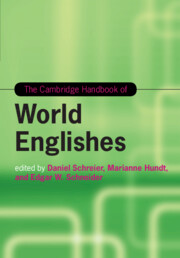Book contents
- The Cambridge Handbook of World Englishes
- Cambridge Handbooks in Language and Linguistics
- The Cambridge Handbook of World Englishes
- Copyright page
- Dedication
- Contents
- Figures
- Maps
- Tables
- Notes on Contributors
- 1 World Englishes: An Introduction
- Part I The Making of Englishes
- Part II World Englishes Old and New
- Part III Linguistics and World Englishes
- 14 The Global Growth of English at the Grassroots
- 15 Beyond English as a Second or Foreign Language: Local Uses and the Cultural Politics of Identification
- 16 World Englishes in Cyberspace
- 17 World Englishes and Their Dialect Roots
- 18 Lexicography and World Englishes
- 19 The Relevance of World Englishes for Variationist Sociolinguistics
- 20 Multilingualism and the World Englishes
- 21 Unearthing the Diachrony of World Englishes
- 22 Corpus-Based Approaches to World Englishes
- 23 World Englishes from the Perspective of Dialect Typology
- 24 Language Acquisition and World Englishes
- Part IV Current Challenges
- Index
- References
21 - Unearthing the Diachrony of World Englishes
from Part III - Linguistics and World Englishes
Published online by Cambridge University Press: 16 December 2019
- The Cambridge Handbook of World Englishes
- Cambridge Handbooks in Language and Linguistics
- The Cambridge Handbook of World Englishes
- Copyright page
- Dedication
- Contents
- Figures
- Maps
- Tables
- Notes on Contributors
- 1 World Englishes: An Introduction
- Part I The Making of Englishes
- Part II World Englishes Old and New
- Part III Linguistics and World Englishes
- 14 The Global Growth of English at the Grassroots
- 15 Beyond English as a Second or Foreign Language: Local Uses and the Cultural Politics of Identification
- 16 World Englishes in Cyberspace
- 17 World Englishes and Their Dialect Roots
- 18 Lexicography and World Englishes
- 19 The Relevance of World Englishes for Variationist Sociolinguistics
- 20 Multilingualism and the World Englishes
- 21 Unearthing the Diachrony of World Englishes
- 22 Corpus-Based Approaches to World Englishes
- 23 World Englishes from the Perspective of Dialect Typology
- 24 Language Acquisition and World Englishes
- Part IV Current Challenges
- Index
- References
Summary
This chapter mainly focuses on research into the history of standard varieties of English in Kachru’s Inner and Outer Circles. There is a long research tradition relating to the diachrony of the two major Inner Circle varieties of British and American English but it is only since about 2000 that there has been a growing number of diachronic studies on the other mother-tongue Englishes, spoken in Ireland, Canada, Australia, and New Zealand. Interest in the historical development of Outer Circle varieties (the so-called New Englishes) is even more recent, with most studies emphasizing the external history of these Englishes. Investigations of the development of linguistic structure are very rare indeed, especially regarding spoken English. One section of this chapter outlines models of the evolution of World Englishes (WEs) and their implications for research. There are also sections on existing corpora that can be used in researching the history of WEs as well as on ongoing corpus compilation and the difficulties such projects meet. Finally, the usefulness of scattered, individual early data for the reconstruction of earlier stages of WEs is illustrated.
Keywords
- Type
- Chapter
- Information
- The Cambridge Handbook of World Englishes , pp. 484 - 505Publisher: Cambridge University PressPrint publication year: 2020
References
- 1
- Cited by



